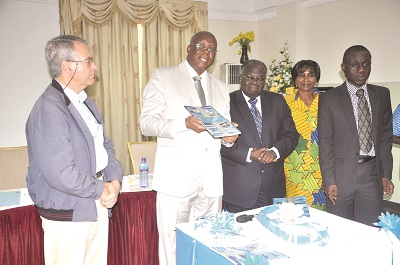National Aquaculture Development Plan launched
 The Ghana National Aquaculture Development Plan (GNADP) designed to increase the national fish stock from 27,750 metric tonnes to 130,000 tonnes in six years was launched in Accra yesterday.
The Ghana National Aquaculture Development Plan (GNADP) designed to increase the national fish stock from 27,750 metric tonnes to 130,000 tonnes in six years was launched in Accra yesterday.
Advertisement
The plan, estimated to cost $85 million, is also intended to generate about 220,000 jobs within the same period.
The cost will be borne by the government, with support from the nation’s development partners.
Launching the plan, the Minister of Fisheries and Aquaculture Development, Mr Nayon Bilijo, said the plan also aimed at enhancing and improving the practice, management and development of aquaculture as a viable business by all stakeholders.
The plan also seeks to engender improvement in production, marketing, environmental sustainability and social acceptance of Ghana’s fish farm enterprise and related aqua chain.
Ghana is among the highest fish consuming countries in the world, with a per capita consumption of 25 kilogrammes, while the world average is 13 kilogrammes.
Fish provides 60 per cent of Ghana’s animal protein requirement.
Mr Bilijo said the establishment of the Ministry of Fisheries and Aquaculture Development and the launch of the first ever blueprint on aquaculture had been necessitated by the annual shortfall in fish production against the increasing demand.
He explained that fish demand for 2012 was estimated at 968,000 metric tonnes, while fish production for the same year stood at 486,000 metric tonnes.
About 175,000 metric tonnes of fish were imported at an estimated cost of $157 million to make up for the shortfall.
Mr Bilijo said the implementation of the plan would include the zoning of high potential aquaculture areas, especially the Volta Lake, the provision of basic infrastructure for high zones such as markets, electricity, roads, capacity development of aquaculture associations and support for the development of improved fish and other aquatic organisms’ seed to fish farmers.
The minister expressed the government’s displeasure at the haphazard siting of cages on the Volta Lake, especially at Sedorm, Gyakiti, Kpeve, Kagyanya and Akuse areas, a situation which, he said, was a precursor to conflict over territories and a potential for the spread of fish diseases among fish farms.
Taking the participants through portions of the plan, the consultant on the plan, Mr Dela Afenyadu, said the vision was a strong basis for the accelerated development of a private sector-led aquaculture that would enable aquaculture to contribute to fish and nutrition security, employment, economic growth and poverty reduction.
By Donald Ato Dapatem



